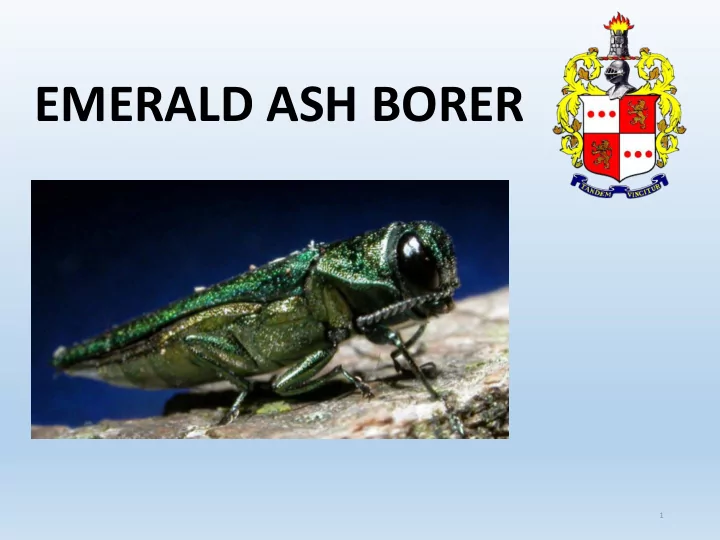

EMERALD ASH BORER 1
INTRODUCTION Freeholder Deborah Smith 2
Richard Wolowicz • • NJ Certified Tree Expert # 281 Contracts with Glen Ridge, Town of Morristown and Hanover Township to • 11 Years in Municipal Forestry provide municipal shade tree management; • • 25 Years in Utility Glen Rock, Kearny and Union City are Forestry/Vegetation Management also served on an as needed basis; • Write Community Forestry Management Plans, Woodlot Management Plans (for Farmland Assessment) and expert Witness Services. 3
PRESENTATION WILL COVER: • Introduction of the pest Origin, Appearance and Detection • Its spread Behavior, Magnitude and Impact • What to expect Completeness and Urgency • Decisions to make 4
Emerald Ash Borer (EAB) • Pest has killed untold millions of ash trees in forest, riparian and urban settings. • Ash species indigenous to China are generally resistant and may eventually provide resistance genes for introgression into North American species. • Spread by natural and human-assisted movement. 5
EAB Basic facts • EAB is an insect pest native to Asia that feeds on ash trees. • It is a small green beetle about 1 cm in length. • EAB was first discovered in North America in 2002 in Detroit, MI & Windsor, ON • EAB kills most native ash species and cultivars. • Adult EAB emerge through a small hole shaped like the letter “D.“ 6
7
How to Identify an Ash Tree 8
How Does the EAB Spread? • Adults fly – up to 2 miles or less • New infestations found near campgrounds • Movement of firewood, nursery stock, and ash waste products 9
How Bad is the Infestation? • Approximately 50 million ash trees in eastern North America have been killed. • Hundreds of millions more are probably currently infested. • Most of the estimated 7.5 billion ash trees in the U.S. are likely to become infested and die as EAB spreads . Dutch Elm Disease killed an estimated 75- 100 million American elms. Chestnut Blight killed an estimated 4 billion American chestnut trees. 10
IMPACT Almost all ash trees die in just a few years if not treated! 11
EAB Infestation Facts • It takes 3-5 years, sometimes longer, for an infested tree to decline and die. • Newly infested trees may show no outward sign of decline for one or more years. • Early signs of infestation include thinning crowns, branch dieback and woodpecker activity. • There is no practical way to prevent EAB from spreading to un-infested areas. 12
IMPACT Public Safety Brittle, dead trees Dangerous to remove 13
A Street in Toledo, Ohio 3 years apart 14
Cranbury, NJ Devastation 15
16
Economic Impacts to Communities • Cost of plan development, inventory and field work • Cost of administration of program • Cost of treatment or removal • Cost of replacement trees • Cost of wood waste disposal • Loss of benefits from removed trees 17
Other Economic Impacts • Cost to the nursery industry • Cost to the wood products industry • Increased air conditioning costs • Decrease in home values 18
Being Proactive is Crucial Treatment Options Ash Mortality from EAB 100 90 80 Percent Mortality 70 60 50 40 30 20 10 0 0 1 2 3 4 5 6 7 8 9 10 11 12 13 14 15 16 Years After First EAB Infestation 19
EAB • Extremely difficult in detecting and delineating infestations; • When damage is evident then the tree is already stressed; • Control strategies: None Biologic Systemic SLAM (slow ash mortality) 20
What we are • 30% or less canopy decline in a given year; looking for when • Evaluating cumulative decline over deciding to treat: multiple years. Acceptable Results Low Pressure High Pressure 21
Options to Consider • Start removing low value ash trees as soon as you can. The earlier you start: • the less available food for EAB, • the less impact to your budget, • the lower the overall cost, • the greater the availability of contractors and equipment. • Start treating high value ash trees. • Start replanting as soon as feasible. • Start to plan a strategy ASAP! 22
Typical Costs for tree management • Cost for Treatment (Not guaranteed to prevent infestation) $7.25/diameter inch every two years for ten years. $650 per 18” tree; • Removal and disposal $465 per tree; • Stump grinding $95 per 18” tree; • Replanting Trees $325 per installed tree. 23
SOURCES WWW.EMERALDASHBORER.NJ.GOV http://nj.gov/agriculture/divisions/pi/pdf/ashutilizers.pdf http://nj.gov/agriculture/divisions/pi/pdf/ashutilizersmap.pdf http://nj.gov/agriculture/divisions/pi/pdf/recycling_trees.pdf RAINBOW TREE CARE 24
Recommend
More recommend